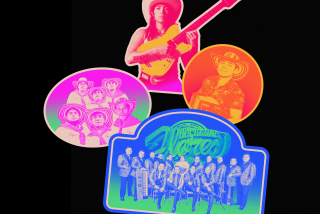A stunning invitation to the party that never was
Cuba Style
Graphics From the Golden Age of Design
Vicki Gold Levi and Steven Heller
Princeton Architectural Press: 168 pp., $20 paper
*
At first glance, “Cuba Style” has all the trappings of a swanky coffee-table tome, that is, if one does only a swan dive into its lush graphics, conjuring a Cuba of the first half of the last century that existed as a place of implacable sunshine, gaiety, rhythm and sensuality. Fortunately, Vicki Gold Levi and Steven Heller have shrewdly crafted something more.
“Visit Cuba” is the book’s lead-off section, and the dream of that “exotic island so near and yet so foreign” is conjured through a parade of graphics resulting in a dizzying high that can make even the most jaded student of disoriented reality want to stand up and let rip, “By God, I want to go there!”
And what a there Cuba was, as portrayed in a plethora of stylish come-hither graphics, tagged with words to vacation by: “The Forever Paradise,” “Holiday Isle of the Tropics,” “Land of Fiesta and Siesta,” “The Prettiest Land Human Eyes Have Ever Seen,” “The Greatest Pleasure Port!” And the glory of it all was that Americans could hop a ferry with their car, fly in a fast plane or sail on a cruise ship right into the “Paris of the Western Hemisphere.” Whew! Where do we buy those tickets?
We can’t, we never could, not to that stylized dreamscape anyway. Cuba’s political and economic realities constantly insinuated their way into the dream. This is made clear in an illustration of a bikini-clad white female “colossus towering over the tiny island of Cuba,” perpetuating “a myth invented by the travel industry.” The female colossus is a not-so-benevolent stand-in for Uncle Sam, projecting the same bludgeoning colonialist message.
Many of the graphics, whether they are travel brochures, cigar box illustrations, magazine covers or movie posters, vibrate with an exuberant mix of sophisticated line and color, calculated to explode a tropical sensibility infused with originality. Perusing this illustrative compilation of the Cuban pop culture’s artistic expression of its time confirms that it was not merely a pale ghost of European origins but an intelligent fusion of Spanish, African and American influences. That is why so much of what is on display vibrantly dances off the page.
There are some obvious choices here, including examples of Cuba’s unique and enduring art form of illustrative cigar boxes and labels, “employing classical graphic idioms to reflect a real or mythical heritage.” As well, there are advertisements for defunct pleasure palace hotels and gambling casinos, shining brilliant light onto a world of privilege often darkly colored by economic and racial segregation.
Film aficionados will be pleased to discover a gallery of Cuban film posters in glorious sun-stunned color. And for good measure, there is the American poster for director Laszlo Benedek’s 1957 film “Affair in Havana,” starring John Cassavetes and Raymond Burr. The poster’s primary image is of a white woman in a bathing suit on the beach. She is startled at the appearance of a swarthy man in a field worker’s straw hat. He is about to offer her the best or worst moment of her life, depending on your cultural point of view.
For those who find Benedek’s B movie fare too sophisticated, the authors have thoughtfully provided a poster of the sensational Rosa Carmina in the vampy 1952 classic “Sandra, the Woman of Fire.” Carmina, in her glittery red-sequined cocktail dress slit up to the thigh, her red hair flowing and her gold hoop earrings glowing, is incendiary enough to start a forest fire on the dark side of the moon.
In the section “Latin Rhythms,” the authors state: “Savage and sensual, repetitive and exhausting, the primitive beat of the conga and bongo -- the confluence of Spanish melodies and African rhythms -- typifies what was Cuban perhaps better than any other manifestation of culture.” Such a sentiment is a hotly debated one by social historians these days, but walk into most music stores in America and the multitudinous beats of Cuba prevail in the sea of world music.
One of the most compelling images in the book is a 1945 postcard of a sensual African Cuban couple dancing an exotic “scarf rumba.” A prosperous white woman looks on, longing to join the party. Now, 57 years later, tourism has replaced sugar as Cuba’s primary source of income, and an army of American tourists is poised once again to march into “the island paradise” the moment the walls of the travel embargo come tumbling down or when the political winds of fate blow in another direction. The big question is, will the party next time include all the Cubans? If not, it too may be destined to suffer a half-century hangover.
More to Read
The biggest entertainment stories
Get our big stories about Hollywood, film, television, music, arts, culture and more right in your inbox as soon as they publish.
You may occasionally receive promotional content from the Los Angeles Times.










